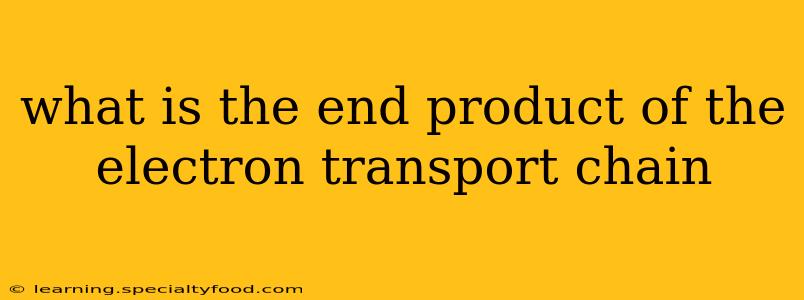What is the End Product of the Electron Transport Chain?
The electron transport chain (ETC), also known as the respiratory chain, is the final stage of cellular respiration. It's a series of protein complexes embedded in the inner mitochondrial membrane (in eukaryotes) or the plasma membrane (in prokaryotes) that facilitate the transfer of electrons from electron donors to electron acceptors via redox reactions. The ultimate end product of this intricate process is water (H₂O). But understanding why water is the end product requires delving into the specifics of the ETC.
How the Electron Transport Chain Works and Produces Water
The ETC begins with the delivery of electrons from NADH and FADH₂, molecules generated during earlier stages of cellular respiration (glycolysis and the Krebs cycle). These electron carriers donate their high-energy electrons to the protein complexes of the ETC. As electrons move through the chain, they progressively lose energy. This energy is harnessed to pump protons (H⁺) across the inner mitochondrial membrane, creating a proton gradient. This gradient is crucial for ATP synthesis – the main purpose of cellular respiration.
The final electron acceptor in the ETC is molecular oxygen (O₂). This is a critical point – without oxygen, the ETC would halt, and cellular respiration would become far less efficient. The oxygen accepts the electrons at the end of the chain, along with protons (H⁺) from the mitochondrial matrix, to form water. This is represented in the following simplified equation:
4e⁻ + 4H⁺ + O₂ → 2H₂O
This seemingly simple equation belies the complexity of the process. The precise mechanisms of electron transfer and proton pumping are highly regulated and involve numerous protein cofactors and intricate conformational changes within the protein complexes.
What Happens if Oxygen Isn't Available?
What happens if oxygen is not the final electron acceptor in the electron transport chain? This is a crucial question, as it highlights the importance of oxygen in aerobic respiration. Without oxygen, the electrons cannot be passed to the final acceptor, causing a backup in the electron transport chain. This leads to a cessation of proton pumping, resulting in a dramatic decrease in ATP production. The cell then resorts to anaerobic respiration (fermentation), a less efficient process that produces far less ATP and generates byproducts such as lactic acid (in animals) or ethanol (in yeast).
The Importance of Water as the End Product
The production of water as the end product of the ETC isn't just a byproduct; it's an essential component of the overall metabolic balance within a cell. The process ensures the continuous flow of electrons and the efficient generation of ATP, the energy currency of the cell. The removal of electrons from the ETC through oxygen reduction prevents the accumulation of harmful reactive oxygen species (ROS), which can damage cellular components.
In summary, the end product of the electron transport chain is water, a critical outcome resulting from the reduction of oxygen and the culmination of a sophisticated process vital for energy production in aerobic organisms. Understanding this process is fundamental to comprehending cellular respiration and the overall energy metabolism of living systems.
